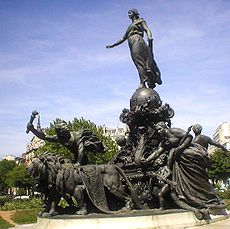Place de la Nation

The Triumph of the Republic
by Aimé-Jules Dalou |
|
| Length | 252 m (827 ft) |
|---|---|
| Width | 252 m (827 ft) (circular with diameter = 252 m) |
| Arrondissement | 11th, 12th |
| Quarter | Sainte-Marguerite . Picpus |
| From | Rue du Faubourg Saint-Antoine |
| To | Avenue du Trône |
| Construction | |
| Completion | Already present on the Delagrive plan in 1728 |
| Denomination | 2 July 1880 |
Coordinates: 48°50′54″N 2°23′45″E / 48.84833°N 2.39583°E
The place de la Nation (formerly place du Trône, subsequently place du Trône-Renversé) is a circle on the eastern side of Paris, between Place de la Bastille and the Bois de Vincennes, along the border of the 11th and 12th arrondissements.
Widely known for having the most active guillotines during the French Revolution, the square was renamed the Place de la Nation on 14 July 1789, Bastille Day.
Featuring a large bronze sculpture, the 'Triomphe de la République', the square is encircled by shops and a flower garden — and is served by the Paris Metro station Nation.
To this day, Paris bears traces of the mur des Fermiers généraux, a wall built between 1784 and 1791, one of the several city walls built between the early Middle Ages to the mid 19th century well beyond the buildings of Paris in a campaign to encircle houses, gardens and monasteries for the purpose of controlling the flow of goods and to enable their taxation by the Farmers General.
The wall's construction left a vast grassy space of vines and market gardens as far as the medieval city wall and the walls of the gardens of the old village of Picpus, filled with large convents, schools and retreats. A throne was erected in this space on 26 July 1660 for the solemn arrival of Louis XIV and Maria Theresa of Spain following their wedding in Saint-Jean-de-Luz. This gave the square its original name of "Square of the Throne", Place du Trône.
...
Wikipedia

